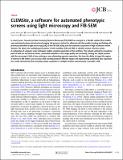Files in this item
CLEMSite, a software for automated phenotypic screens using light microscopy and FIB-SEM
Item metadata
| dc.contributor.author | Serra Lleti, José M. | |
| dc.contributor.author | Steyer, Anna M. | |
| dc.contributor.author | Schieber, Nicole L. | |
| dc.contributor.author | Neumann, Beate | |
| dc.contributor.author | Tischer, Christian | |
| dc.contributor.author | Hilsenstein, Volker | |
| dc.contributor.author | Holtstrom, Mike | |
| dc.contributor.author | Unrau, David | |
| dc.contributor.author | Kirmse, Robert | |
| dc.contributor.author | Lucocq, John M. | |
| dc.contributor.author | Pepperkok, Rainer | |
| dc.contributor.author | Schwab, Yannick | |
| dc.date.accessioned | 2023-01-20T15:30:07Z | |
| dc.date.available | 2023-01-20T15:30:07Z | |
| dc.date.issued | 2023-03-06 | |
| dc.identifier | 283032574 | |
| dc.identifier | 6a37a648-1c83-4bef-ae36-e890edaff07e | |
| dc.identifier | 85144635757 | |
| dc.identifier.citation | Serra Lleti , J M , Steyer , A M , Schieber , N L , Neumann , B , Tischer , C , Hilsenstein , V , Holtstrom , M , Unrau , D , Kirmse , R , Lucocq , J M , Pepperkok , R & Schwab , Y 2023 , ' CLEM Site , a software for automated phenotypic screens using light microscopy and FIB-SEM ' , Journal of Cell Biology , vol. 222 , no. 3 , e202209127 . https://doi.org/10.1083/jcb.202209127 | en |
| dc.identifier.issn | 0021-9525 | |
| dc.identifier.other | Jisc: 820131 | |
| dc.identifier.other | ORCID: /0000-0002-5191-0093/work/127065382 | |
| dc.identifier.uri | https://hdl.handle.net/10023/26798 | |
| dc.description | Funding: This work was supported by EMBL funds and by by the Deutsche Forschungsgemeinschaft (DFG, German Research Foundation) – Project number 240245660 – SFB 1129 (project Z2). | en |
| dc.description.abstract | In recent years, Focused Ion Beam Scanning Electron Microscopy (FIB-SEM) has emerged as a flexible method that enables semi-automated volume ultrastructural imaging. We present a toolset for adherent cells that enables tracking and finding cells, previously identified in light microscopy (LM), in the FIB-SEM, along with the automatic acquisition of high-resolution volume datasets. We detect the underlying grid pattern in both modalities (LM and EM), to identify common reference points. A combination of computer vision techniques enables complete automation of the workflow. This includes setting the coincidence point of both ion and electron beams, automated evaluation of the image quality and constantly tracking the sample position with the microscope’s field of view reducing or even eliminating operator supervision. We show the ability to target the regions of interest in EM within 5 µm accuracy while iterating between different targets and implementing unattended data acquisition. Our results demonstrate that executing volume acquisition in multiple locations autonomously is possible in EM. | |
| dc.format.extent | 26 | |
| dc.format.extent | 6946849 | |
| dc.language.iso | eng | |
| dc.relation.ispartof | Journal of Cell Biology | en |
| dc.subject | Cell biology | en |
| dc.subject | QH301 Biology | en |
| dc.subject | DAS | en |
| dc.subject | MCC | en |
| dc.subject.lcc | QH301 | en |
| dc.title | CLEMSite, a software for automated phenotypic screens using light microscopy and FIB-SEM | en |
| dc.type | Journal article | en |
| dc.contributor.institution | University of St Andrews. School of Medicine | en |
| dc.contributor.institution | University of St Andrews. Biomedical Sciences Research Complex | en |
| dc.contributor.institution | University of St Andrews. Cellular Medicine Division | en |
| dc.identifier.doi | 10.1083/jcb.202209127 | |
| dc.description.status | Peer reviewed | en |
This item appears in the following Collection(s)
Items in the St Andrews Research Repository are protected by copyright, with all rights reserved, unless otherwise indicated.

